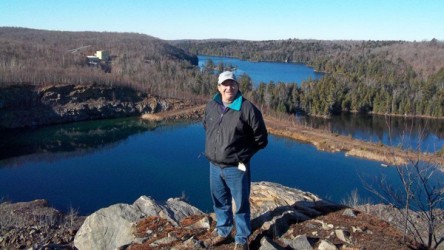Article Origin
Volume
Issue
Year
Right from the get-go, the province and Ontario Graphite Ltd. got off on the wrong foot in Aboriginal consultations to re-activate a graphite mine near the town of Kearney.
The graphite mine sits near the town and above an important water system located in the traditional territory of six Anishinabek communities. In particular, Magnetawan First Nation is worried about their water from the Magnetawan River if the re-activation proposal goes through. If the mine is allowed to re-open operations, there could be a potential for pollutants to leach into the river system.
The communities learned last fall that the company wanted to re-open the site to mine for graphite. The mine had been in operation during 1989 to 1994, by a different company. Anthony Laforge, director of Lands and Resources at Magnetawan First Nation, suspects the mine under previous management was not closed down properly.
An environmental news publication reports the Ministry of Environment charged International Graphite with 14 charges under the Ontario Water Resources Act (OWRA) for failing to comply with a Certificate of Approval plus six counts under the Environmental Protection Act for failing to comply with a control order in respect to offences from May 1999 and January 2001.
The water charges were related to the mine’s polishing and tailings pond, from open pit water and from the Magnetawan River, as well as not maintaining proper pH levels in the tailings pond nor having adequate equipment.
Considering the history of the mine site, First Nations are worried because not only could pollution leak into the Magnetawan River affecting Magnetawan First Nations’ drinking water, but could also contaminate Georgian Bay.
As part of the ‘Aboriginal consultations,’ First Nations were handed a closure plan by Ontario Graphite Ltd, just before Christmas break last year along with 30 days to reply.
“We were provided with a document the size of War and Peace. We were overwhelmed and didn’t have a very long time to look it over,” said Laforge. He also said the First Nation didn’t have the capacity to review such a technical document.
The First Nation hired a University researcher to review the closure plan and provide a report. George Morgan with Laurentian University analyzed the closure plan for Magnetawan First Nation and had many concerns. His main concern is “the possibility of acidic water and associated metal contamination flowing into waterbodies and adversely affecting the aquatic environment of Graphite Lake, Minnow Lake, McGuire Lake, South Pond and the Magnetawan River.”
Morgan also points out elevated levels of heavy metals in the groundwater when the previous company was under investigation. In his report, Morgan said, “During the 1994 investigations, it was found that some of the velocities were so high that they could not be measured with conventional equipment and it was suggested that some velocities might be 100 times higher than those reported.” Corrective measures taken to clean up or re-balance the pH levels in the tailings pond have also not worked, according to Morgan.
Along with environmental concerns, First Nations are upset with the way the province and company have been conducting ‘Aboriginal consultations.’ The most alarming incident included a phone call from a Ministry of Environment employee calling First Nation leadership, in a bid for them to accept the plan. Henvey Inlet First Nation Chief Wayne McQuabbie said, “They were trying to bulldoze the plan and process through.”
The communities had been attempting to engage the province with their concerns as well as seek acknowledgement about Morgan’s report. That’s when they pulled in the Union of Ontario Indians. The UOI had also tried to engage the Minister of Northern Development of Mines, and it took several months before the province got back to them.
The Union of Ontario Indians has since formed a bi-lateral table with the province to address mines and the Northern Growth Plan. Lake Huron Regional Chief Isadore Day said, “Ontario has done a poor job with First Nations in the province, and the Anishinabek disagree with its approach and we want to ensure things move forward.”
While First Nations are seeking ‘meaningful consultation’ on this project, they’re also looking for resource benefit sharing if a proper closure plan can be presented. However, resource benefit sharing was never mentioned by the province or the company. Laforge said, “The company only mentioned it could post jobs and provide a few scholarships.”
In an email statement from the Ministry of Northern Development and Mines, Communications Coordinator Laura Blondeau said, “The ministry is committed to appropriately addressing its obligations to consult with Aboriginal communities when making decisions which have the potential to adversely affect the exercise of Aboriginal or treaty rights. As such, we rely on communities to engage with us and to identify their concerns so that those concerns can be addressed, where appropriate….”
Ontario Graphite Ltd. has been hoping to begin production at the open pit mine in mid-2012. First Nations in the area are glad operations haven’t started yet, since they want more consultation and a better closure plan for the largest confirmed graphite mineral resource deposit in North America. Phone calls and emails to Ontario Graphite Ltd. were not returned.
Graphite is used in products like lithium-ion batteries which are used in electric and hybrid cars. The price of graphite has been steadily increasing over the years due to the use in new technologies. Graphite is worth more than four times as much now than it was worth in the 1990s.
- 5850 views

